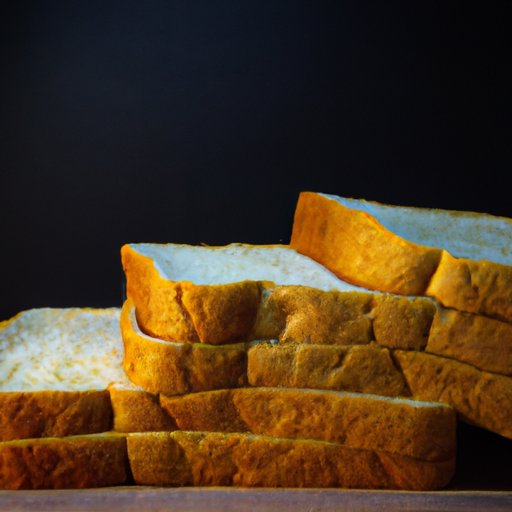Introduction
Bread is one of the most widely consumed foods in the world. It is made from flour, water, salt, and yeast and can be found in almost every culture. While bread has been part of human diets for millennia, its health benefits and risks have been the subject of debate. In this article, we will explore the health benefits and risks associated with eating bread.
Comparing the Health Benefits of Different Types of Bread
The health benefits of bread depend on the type of bread being consumed. For example, whole wheat bread is typically higher in fiber than white bread, while white bread may contain added vitamins and minerals. It is important to read the nutritional labels on bread packages to compare the nutritional content of different types of bread.
Whole wheat bread is a good source of dietary fiber, which can help reduce cholesterol levels, improve digestion, and regulate blood sugar levels. It also contains essential vitamins and minerals such as thiamin, riboflavin, niacin, vitamin B6, folate, iron, magnesium, and zinc. White bread, on the other hand, may contain added vitamins and minerals, but it is lower in fiber than whole wheat bread.
In addition to comparing the nutritional content of different types of bread, it is also important to consider the potential health benefits of each type of bread. According to a study published in the American Journal of Clinical Nutrition, whole grain breads may help reduce the risk of cardiovascular disease, diabetes, and certain cancers. The study also found that whole grain breads may help reduce inflammation, improve digestive health, and support weight loss.
Examining the Nutritional Content of Bread and its Impact on Overall Health
Bread can be an excellent source of essential vitamins and minerals. Whole wheat bread, for example, is a good source of thiamin, riboflavin, niacin, vitamin B6, folate, iron, magnesium, and zinc. These nutrients are important for maintaining overall health and can help support immune function, bone health, and neurological function.
Bread is also a good source of carbohydrates, which are an important source of energy. However, it is important to note that not all carbohydrates are created equal. Refined carbohydrates, such as those found in white bread, can cause spikes in blood sugar levels, while complex carbohydrates, such as those found in whole grain breads, are more slowly digested and absorbed by the body.

Exploring the Role of Bread in a Balanced Diet
Bread can be an important part of a balanced diet. It is a good source of essential vitamins and minerals, as well as a source of carbohydrates for energy. To ensure you are getting the most out of your bread consumption, it is important to choose whole grain varieties such as whole wheat or rye bread. Additionally, it is important to limit refined carbohydrates such as white bread, and opt for complex carbohydrates instead.
It is also important to consume bread in moderation. According to the Dietary Guidelines for Americans, adults should consume no more than 6 ounces of grains per day, with at least half of those grains coming from whole grains. This means that bread should only make up a small portion of your daily caloric intake.

Investigating Potential Health Risks Associated with Eating Too Much Bread
Eating too much bread can have a negative impact on overall health. Consuming large amounts of refined carbohydrates, such as those found in white bread, can cause spikes in blood sugar levels and increase the risk of developing diabetes. Additionally, eating too much bread can lead to weight gain, as bread is high in calories and can contribute to overeating.
To minimize the potential health risks associated with eating bread, it is important to limit your consumption of refined carbohydrates and opt for whole grain varieties instead. Additionally, it is important to consume bread in moderation and as part of a balanced diet.

Debunking Common Myths About Bread and Health
There are many myths surrounding bread and health. One of the most common myths is that bread is unhealthy. This is simply not true. While some types of bread, such as white bread, can be unhealthy if consumed in large quantities, whole grain breads can be an important part of a balanced diet.
Another myth is that all breads are equally nutritious. This is also not true. While all breads contain some essential vitamins and minerals, whole grain breads are typically higher in fiber and other nutrients than white bread. Therefore, it is important to read the nutritional labels on bread packages to compare the nutritional content of different types of bread.
Conclusion
Bread can be an important part of a balanced diet. It is a good source of essential vitamins and minerals, as well as a source of carbohydrates for energy. However, it is important to choose whole grain varieties such as whole wheat or rye bread, and to limit refined carbohydrates such as white bread. Additionally, it is important to consume bread in moderation and as part of a balanced diet.
Ultimately, bread can be a healthy part of your diet when consumed in moderation and as part of a balanced diet. It is important to understand the nutritional content of different types of bread, as well as the potential health benefits and risks associated with consuming bread.
(Note: Is this article not meeting your expectations? Do you have knowledge or insights to share? Unlock new opportunities and expand your reach by joining our authors team. Click Registration to join us and share your expertise with our readers.)
